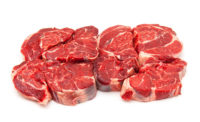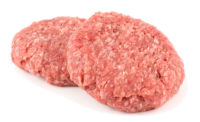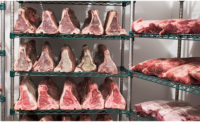According to a recent review, the average American consumes about 66 pounds of ground beef per year, and ground beef accounts for approximately 60 percent of total beef consumption.
Ground beef can be derived from a number of beef primals which can vary in saturated fat (SFA) and monounsaturated fat levels (MUFA). We have demonstrated that ground beef available at retail has a MUFA:SFA ratio of 0.85 to 0.90, whereas ground beef from cattle fed high-grain diets has a MUFA:SFA ratio greater than 1.10. Ground beef from grass-fed animals has a MUFA:SFA ratio less than 0.75.
We have shown in three separate human studies that ground beef with a MUFA:SFA ratio greater than 1.0 increases HDL (“good”) cholesterol more than ground beef with a MUFA:SFA ratio less than 1.0.
In ground beef, MUFA:SFA ratio can be altered by replacement of SFAs with fat trims rich in oleic acid. It has been previously reported that subcutaneous adipose tissue over the brisket is typically high in MUFAs, especially in oleic acid, and low in palmitic and stearic acids, the major SFAs in beef. Fat from the plate primal is intermediate in SFA and the flank has the highest SFA proportions.
Our objective was to evaluate the fatty acid composition, trained sensory flavor descriptive attributes, and lipid- and Maillard-derived volatile flavor compounds of beef produced from the lean and fat trims of brisket, flank and plate primals.
We removed the brisket, flank and plate primals from 4 USDA A maturity Select young beef carcasses at a commercial beef processor. From each primal, the lean and fat portions were separated and reformulated into ground beef that contained 10, 20 and 30 percent of total fat across the three primals. Brisket ground-beef patties contained higher MUFAs and less SFA (MUFA:SFA ratio = 1.03) than ground beef patties from the flank (MUFA:SFA ratio = 0.77), but ground beef patties did not differ in n-6 or n-3 fatty acids across primals and fat level. Plate ground beef patties had a MUFA:SFA ratio = 0.99.
Cooked brisket ground-beef patties were higher in bloody/serumy and fat-like flavor attributes than ground-beef patties from the flank, which are highly desirable, but plate ground-beef patties had higher amounts of lipid-derived flavor volatiles. Similarly, ground-beef patties from the plate had more Maillard-derived volatiles than flank ground-beef patties, and brisket patties had higher levels of flavor volatile compounds perceived as pleasant.
This study demonstrates ground beef produced from the brisket, flank and plate have a unique fatty acid and functional characteristics, and these primals can be used to produce ground beef with distinctive compositional and flavor attributes. These primal-formulated ground-beef patties have sufficient differences in fatty acid levels to be promoted as healthy alternatives to traditional ground-beef products.




Report Abusive Comment